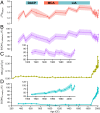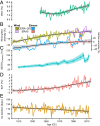Changing nutrient cycling in Lake Baikal, the world's oldest lake
- PMID: 33077588
- PMCID: PMC7959572
- DOI: 10.1073/pnas.2013181117
Changing nutrient cycling in Lake Baikal, the world's oldest lake
Abstract
Lake Baikal, lying in a rift zone in southeastern Siberia, is the world's oldest, deepest, and most voluminous lake that began to form over 30 million years ago. Cited as the "most outstanding example of a freshwater ecosystem" and designated a World Heritage Site in 1996 due to its high level of endemicity, the lake and its ecosystem have become increasingly threatened by both climate change and anthropogenic disturbance. Here, we present a record of nutrient cycling in the lake, derived from the silicon isotope composition of diatoms, which dominate aquatic primary productivity. Using historical records from the region, we assess the extent to which natural and anthropogenic factors have altered biogeochemical cycling in the lake over the last 2,000 y. We show that rates of nutrient supply from deep waters to the photic zone have dramatically increased since the mid-19th century in response to changing wind dynamics, reduced ice cover, and their associated impact on limnological processes in the lake. With stressors linked to untreated sewage and catchment development also now impacting the near-shore region of Lake Baikal, the resilience of the lake's highly endemic ecosystem to ongoing and future disturbance is increasingly uncertain.
Keywords: Siberia; climate; ecosystem; endemic; limnology.
Copyright © 2020 the Author(s). Published by PNAS.
Conflict of interest statement
The authors declare no competing interest.
Figures




Similar articles
-
Diatom evidence of 20th century ecosystem change in Lake Baikal, Siberia.PLoS One. 2018 Dec 19;13(12):e0208765. doi: 10.1371/journal.pone.0208765. eCollection 2018. PLoS One. 2018. PMID: 30566423 Free PMC article.
-
Mercury loading within the Selenga River basin and Lake Baikal, Siberia.Environ Pollut. 2020 Apr;259:113814. doi: 10.1016/j.envpol.2019.113814. Epub 2019 Dec 16. Environ Pollut. 2020. PMID: 32023784
-
Mitochondrial and nuclear DNA phylogeography of Thymallus spp (grayling) provides evidence of ice-age mediated environmental perturbations in the world's oldest body of fresh water, Lake Baikal.Mol Ecol. 2002 Dec;11(12):2599-611. doi: 10.1046/j.1365-294x.2002.01642.x. Mol Ecol. 2002. PMID: 12453243
-
Tectonics of the baikal rift deduced from volcanism and sedimentation: a review oriented to the Baikal and Hovsgol lake systems.Prog Mol Subcell Biol. 2009;47:27-54. doi: 10.1007/978-3-540-88552-8_2. Prog Mol Subcell Biol. 2009. PMID: 19198772 Review.
-
The ecology of the planktonic diatom Cyclotella and its implications for global environmental change studies.Biol Rev Camb Philos Soc. 2015 May;90(2):522-41. doi: 10.1111/brv.12120. Epub 2014 Jun 11. Biol Rev Camb Philos Soc. 2015. PMID: 24917134 Review.
Cited by
-
Postglacial adaptations enabled colonization and quasi-clonal dispersal of ammonia-oxidizing archaea in modern European large lakes.Sci Adv. 2023 Feb 3;9(5):eadc9392. doi: 10.1126/sciadv.adc9392. Epub 2023 Feb 1. Sci Adv. 2023. PMID: 36724220 Free PMC article.
-
Response of Aquatic Organisms Communities to Global Climate Changes and Anthropogenic Impact: Evidence from Listvennichny Bay of Lake Baikal.Biology (Basel). 2021 Sep 13;10(9):904. doi: 10.3390/biology10090904. Biology (Basel). 2021. PMID: 34571780 Free PMC article.
-
New and Interesting Taxa from the Diatom Genus Gomphonema Ehrenberg in Shallow, Nearshore Sites on the Eastern Coast of Lake Baikal.Plants (Basel). 2023 Apr 29;12(9):1835. doi: 10.3390/plants12091835. Plants (Basel). 2023. PMID: 37176894 Free PMC article.
-
Emerging unprecedented lake ice loss in climate change projections.Nat Commun. 2022 Oct 2;13(1):5798. doi: 10.1038/s41467-022-33495-3. Nat Commun. 2022. PMID: 36184681 Free PMC article.
-
The first arriving virus shapes within-host viral diversity during natural epidemics.Proc Biol Sci. 2023 Sep 13;290(2006):20231486. doi: 10.1098/rspb.2023.1486. Epub 2023 Sep 13. Proc Biol Sci. 2023. PMID: 37700649 Free PMC article.
References
-
- O’Reilly C. M.et al. ., Rapid and highly variable warming of lake surface waters around the globe. Geophys. Res. Lett. 42, 10773–10781 (2015).
-
- Hall S. R., Mills E. L., Exotic species in large lakes of the world. Aquat. Ecosyst. Health Manage. 3, 105–135 (2000).
-
- Vadeboncoeur Y., McIntyre P. B., Zanden M. J. V., Borders of biodiversity: Life at the edge of the world’s large lakes. Bioscience 61, 526–537 (2011).
Publication types
MeSH terms
LinkOut - more resources
Full Text Sources

